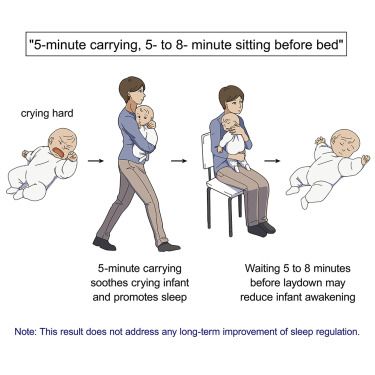Is there a magic formula for getting a fussy baby to sleep? A recent study out of Japan thinks so.
Even if you’re only a few days into it, you’ve probably noticed that picking up and walking around with a crying baby tends to calm them down a bit. This is called the “transport response” which is something babies come hardwired with, and if you think about it, makes a lot of sense. You don’t want to be squawking like a rooster at dawn while mom tries to hide you from a saber tooth tiger, right?
Well, researchers in Japan noticed that while there is a lot of information out there about addressing long term sleep solutions, there wasn’t a ton of scientifically backed, immediately actionable tips for parents who might be on the verge of booking a one-way solo ticket to Bermuda (or worse, hurting the baby.)
Enter the 5-8 Formula.
It’s incredibly simple:
- Pick up the crying baby (carrying is key here, not using a stroller)
- Walk around without making any sharp turns for five minutes
- Sit with the baby for five to eight minutes
- Put them in their crib

What's the science behind this?
The long and short of it is that carrying a crying baby slows their heart rate allowing them to calm down enough to hopefully fall asleep. Sitting for five to eight minutes after their five minute stroll seemed to be the perfect window for being able to put them down in a crib before they exited “stage 1 sleep” (a point in the sleep cycle with a low arousal threshold).
The study also showed (to nobody’s surprise) that babies have an incredible sense for maternal movement and presence. Standing, turning, and leaning (you know, all the things you might do when transitioning to the crib) registered as “events” to sleeping babies, making your job even harder.
But, they also found that placing a hand on a stirring baby’s chest registered as a calming signal and was enough to keep some babies from waking after being transferred to the crib.
You say science, I say instinct.
This might be instinctual for some parents, but it’s still pretty cool to see that science backs it up. Not to mention, when you’re sleep deprived and new at this whole thing, having something tangible spelled out for you can be a godsend.
Will this work for everybody? No.
Transport response be damned, your kid might have deduced that they’re safe from saber toothed tigers and can scream without fear of being turned into dinner.
But, coming from someone who birthed a bedtime banshee, I can say with certainty that anything that only required 13 minute of my time would have been worth trying.
This didn’t work. Now what?
Okay, first? Put the baby down somewhere safe. If they’re crying in your arms, there’s no harm in them crying in their crib for a bit. If you can tap someone else in, go ahead and give them the finger… wait, no, not that finger - point at them. Tell them to go get it done.
Next, get some distance from all that squawking. Pop in some headphones or go for a walk if you can. Drink some water. Eat something if you’re hungry. Take care of you so you can take care of them.
There are tons of resources with a billion different ways to create healthy sleep habits (here’s a great overview of them) but it all starts with you having the mental and physical energy to get through it… which you WILL. It just might take longer than you'd like.
Did you try the 5-8 Formula for getting a fussy baby to sleep?
Let us know in the comments below if it worked or not!
Our next reco: The Witching Hour: How to Handle Your Newborn Baby's Evening Fussiness




Leave a Comment